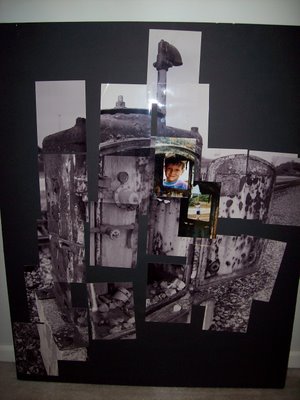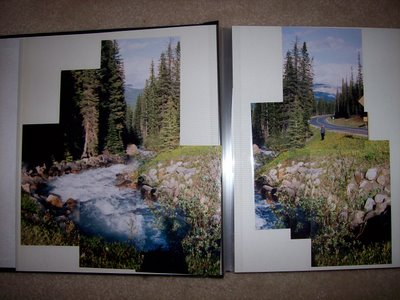Sad news from best friend Steve Wainstead regarding two senseless killings in Cleveland. One of the victims was Masumi Hayashi, an artist and professor who introduced Steve to photo collages. Steve then introduced them to me. From the Cleveland Plain Dealer report:
Masumi Hayashi complained for months about the ear-shattering music her eccentric neighbor blasted through a massive stereo system.
When she took exception to the loudness Thursday evening, the neighbor responded with a barrage of gunfire, killing Hayashi and another resident, police said.
Suddenly, the local art community had been robbed of two vibrant, creative souls, said friends, relatives and artists.
On Friday, they mourned the deaths of Hayashi, 60, a world-renowned photographer and professor; and John Jackson, 51, a respected sculptor, painter and woodworker.
"She was always direct," Keesey said. "She just felt that if you talked to people directly, you could get things done."
Aside from garnering national attention for her photography, Hayashi taught art at Cleveland State University for 24 years. She had won a Cleveland Arts Prize, three Ohio Arts Council awards and a Fulbright fellowship. Her work has been shown in New York, Los Angeles, London and Tokyo.
As a teacher, "she was critical always in a positive way," said Steve Wainstead of New York, software development manager for an online photo site who took courses from Hayashi in the 1990s. "I never heard her say a harsh word of criticism."I was in turn inspired by Steve. I complained to him about the limitations of the camera. Images on prints always looked too small to me. The images only captured a two-dimensional cut of the world the photographer saw. He suggested I try shooting some collages. I was hooked. The collages gave a greater sense of action, and you could emphasize certain features of the subject by moving closer to them, of by leaving gaps in space in the layout, allowing the mind to fill in.
Actually, I liked Steve's and Hockney's collages better than Masumi's. Hers were very precise panoramas. They were interesting in giving that perspective, but they were too naturalist for me. They made no value judgments on the details within the chosen subject. I preferred highlighting those things that spoke most to me within a subject that generally spoke to me. Link to a Hockney collage.
But that's nitpicking. I owe a debt to Masumi for her influence on Steve. I continue to shoot photo collages today, even if I'm really slow about assembling them, thanks to the campaign. Some of my favorite collages of hers were shot at Japanese-American WW2 internment camps. She was born in one, and returned to several of internment sites. Link. Masumi's statement on the camps. LA Times obit.
Here are some of my photo collages:

"The Return Trip From Ohio". Steve got me hooked on the collages, and then set me up for a showing of them in a gallery setting in 1997! I'm no artist! Steve and I did a circle tour of Ohio in July, 1997. Here Steve walks back to Ohio from Indiana across an abandoned railroad bridge. I really like how despite the sparse presentation, the mind fills in the blanks rather well. It captured the sense of being in the middle of nowhere, and also a place fading from use. It's still framed, and measures 30" x 32".
 I shot this collage in about nine years ago. It's primarily black & white, with the exception being the two images of my son, Alex, who was five at the time. The location is Cleveland, on the former Erie Railroad line by the Von Willer Yard, near E. 55th Street. This was near my home at that time. These were dark, trying days for me, and Alex was my brightest bright spot. I was pretty really unaware that I was expressing that so clearly when I shot it. The railroad was a pretty rundown property, and Alex was wearing bright colors and a bright smile. The choice of film seemed appropriate, but more than I knew. This remains my favorite collage as art. It's 40" x 32" in size. I never framed it, and did not show it. It was too personal at the time.
I shot this collage in about nine years ago. It's primarily black & white, with the exception being the two images of my son, Alex, who was five at the time. The location is Cleveland, on the former Erie Railroad line by the Von Willer Yard, near E. 55th Street. This was near my home at that time. These were dark, trying days for me, and Alex was my brightest bright spot. I was pretty really unaware that I was expressing that so clearly when I shot it. The railroad was a pretty rundown property, and Alex was wearing bright colors and a bright smile. The choice of film seemed appropriate, but more than I knew. This remains my favorite collage as art. It's 40" x 32" in size. I never framed it, and did not show it. It was too personal at the time.

Personal collages are mainly what I shoot anymore, so they are meant to be semi-artistic, but really are documents for my own enjoyment. This collage is broken in half so that it could fit in a photo album. The setting is Banff, Alberta. Ame & I honeymooned there in 2003.
All of my photo albums have little collages like these in them. I routinely shoot collages whenever I travel. The trip to the Adirondacks was no different. I shot at least two collages, but they are not yet assembled.
2 comments:
There are beautiful collages. Stunning, stunning, stunning! i was impressed by them. Good work!
I'll have to show you the one that I took on top of Little Round Top at the Gettysburg battle site.
Post a Comment